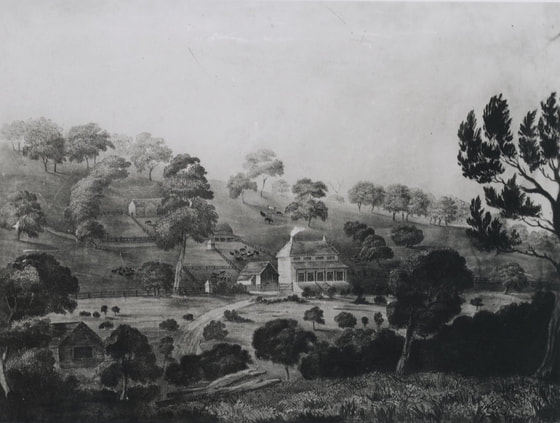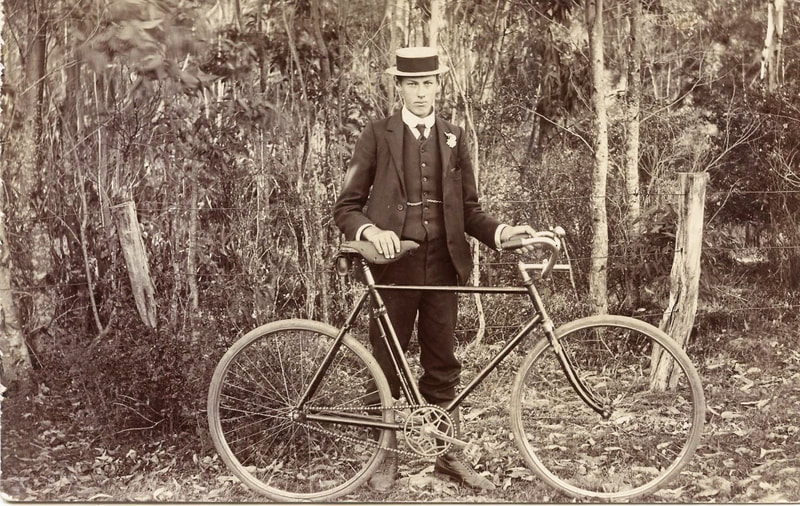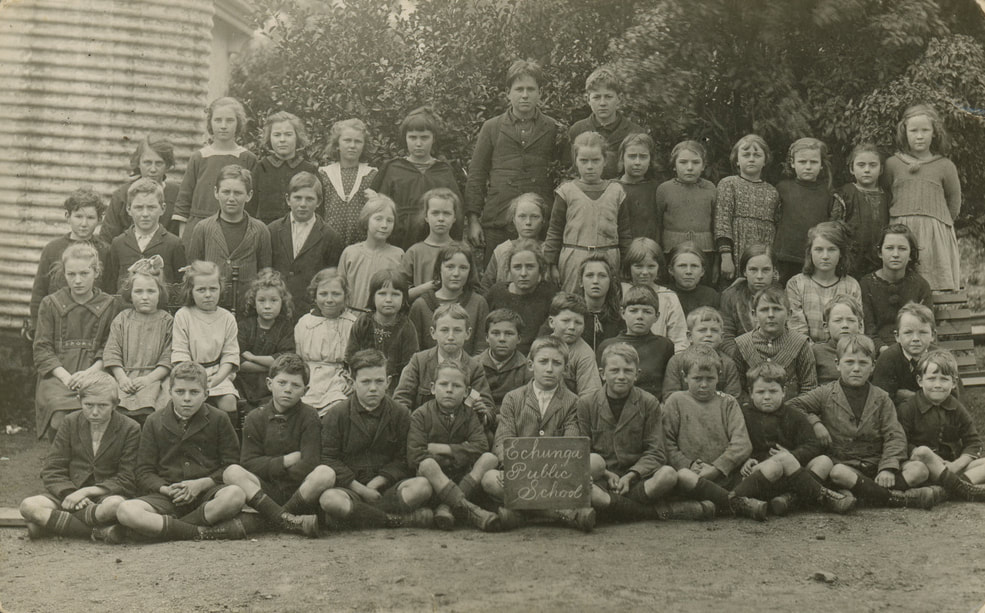Royal Mail Coach pulled up outside the Hagen Arms Hotel, approximately 1894
Peramangk People
The original inhabitants of Echunga were the Peramangk people. The Peramangk lived in the strip of country running north from Mount Barker to the Angaston district and south to Strathalbyn. The Peramangk maintained a good supply of water and plentiful amount of food; they rarely needed to move down onto the Adelaide plains in search of food. They traded with the Aboriginal people in adjoining nations, supplying flint, quarts, supple whip-stick mallee spears, opossum skins and other items not found on the plains and lower lakes.
Within the community, the men would hunt for animal food while the women gathered vegetables, cared for the children and maintained the campsite. They would remain at a campsite for several days before moving to prevent over-use of the area and its food supply and resources, thus ensuring the environment for future generations over thousands of years. Their diet varied according to the season with vegetables, seeds, honey, eggs, grubs, insects, lizards, snakes, fish, yabbies, opossums, and larger game such as kangaroos, wallabies and emus, but depended on traditional laws of season and permissions of access. The people wore very little clothing, especially in summer, but the women were more likely to wear a cloak of opossum fur or kangaroo skin.
Summary by: Ivan-Tiwu Copley 2009.
Within the community, the men would hunt for animal food while the women gathered vegetables, cared for the children and maintained the campsite. They would remain at a campsite for several days before moving to prevent over-use of the area and its food supply and resources, thus ensuring the environment for future generations over thousands of years. Their diet varied according to the season with vegetables, seeds, honey, eggs, grubs, insects, lizards, snakes, fish, yabbies, opossums, and larger game such as kangaroos, wallabies and emus, but depended on traditional laws of season and permissions of access. The people wore very little clothing, especially in summer, but the women were more likely to wear a cloak of opossum fur or kangaroo skin.
Summary by: Ivan-Tiwu Copley 2009.
Peramangk hut., photo copyright Andrew Holt Photography; Peramank art; Shield cut from the bark of a tree, photo copyright Andrew Holt Photography.
European Settlement
The first European settlement was marked by English Quaker, John Barton Hack’s purchase of the Three Brothers Survey (named for a range of three hills) in 1839. Here, he established Echunga Gardens, an English style estate with dairy, wheat, orchards and vineyards. The first wine exported from South Australia was made from grapes grown on Hack’s property.
Hack bankrupted himself during the depression in 1843, the property and his other businesses proving too much of a financial burden. The estate was then taken on by Jacob Hagen, who retained a large mortgage. And even with the associated hardships of the depression, the area was home to beautiful and successful farms, orchards and vineyards.
Hack bankrupted himself during the depression in 1843, the property and his other businesses proving too much of a financial burden. The estate was then taken on by Jacob Hagen, who retained a large mortgage. And even with the associated hardships of the depression, the area was home to beautiful and successful farms, orchards and vineyards.
John Barton Hack's farm, approx 1842
Hagen bought and subdivided two sections to start the township the following year. The Echunga Hotel was erected in 1851, the first building in the district. It was replaced by the current Hagen Arms in 1858. The Bridge Hotel was also built around a similar time.
Hagen Arms Hotel, approximately 1900.
The Business Directories from 1851-1871 recorded a variety of occupation in Echunga, storekeepers, postmen, licensed victuallers, carpenters, joiners, builders, shoemakers, blacksmiths, wheelwrights, nurserymen and seedsmen, butchers, a police corporal, teachers, a catechist, potter, bakers, a ranger, carrier, cabinet maker, saddler and fishmonger.
1. J. Jacobs, butcher, standing in bushland with his horse and cart, 1880.
2. Group of early pioneers, 1890; on the left is Robert Lewis, married to Sarah Palmer in Bristol 1838 and arrived to SA aboard the William Mitchell on 27th Aug 1840 with their two children. Robert died on 6th Oct 1889 in the Adelaide hospital. Image courtesy of Glenys Savage.
3. Mr. Patrick Kavanagh ploughing at Echunga with a single furrow plough drawn by two horse team, approximately 1890.
2. Group of early pioneers, 1890; on the left is Robert Lewis, married to Sarah Palmer in Bristol 1838 and arrived to SA aboard the William Mitchell on 27th Aug 1840 with their two children. Robert died on 6th Oct 1889 in the Adelaide hospital. Image courtesy of Glenys Savage.
3. Mr. Patrick Kavanagh ploughing at Echunga with a single furrow plough drawn by two horse team, approximately 1890.
The first church in Echunga, St Mary’s, was built on land conveyed by Jacob Hagen to Bishop Short in 1850. The Wesleyan Chapel was built in 1857 and the new Methodist Church was built in 1884 on land donated by Miss Sophia Hagen the daughter of Jacob Hagen.
By 1866 the town was home to 1,119 people, 226 houses and 1,772 acres of land under cultivation. The original Institute was opened in 1880.
By 1866 the town was home to 1,119 people, 226 houses and 1,772 acres of land under cultivation. The original Institute was opened in 1880.
St. Mary's Church, 1933. Methodist Church, Echunga, 1933.
Coaching in Echunga
A mail service can be dated back to 1842, which led to the spring cart run by Donald Gollan in 1844 connecting Echunga Springs, Watergate (near Flaxley), Macclesfield and Strathalbyn, and R.Jones’ weekly service between Echunga and Adelaide which started in 1848.
This led to Echunga becoming a staging post, and by the end of the 1860s two coaching companies, Hill & Co. and Cobb & Co., set up stations in the town, which ran successfully until the rail services were introduced leading to the decline of the coaching industry, and the companies were sold in 1919 to a motorised company. Today, we have our friendly postmaster, Greg. With no postal delivery in the area, no day is complete for the Echungian without a chat to Greg.
This led to Echunga becoming a staging post, and by the end of the 1860s two coaching companies, Hill & Co. and Cobb & Co., set up stations in the town, which ran successfully until the rail services were introduced leading to the decline of the coaching industry, and the companies were sold in 1919 to a motorised company. Today, we have our friendly postmaster, Greg. With no postal delivery in the area, no day is complete for the Echungian without a chat to Greg.
Horse drawn passenger coach, approximately 1880, photo from the Samuel Sweet collection.
(Possibly a Wayzgoose or printers picnic marking the start of the season that printers would work by candlelight)
(Possibly a Wayzgoose or printers picnic marking the start of the season that printers would work by candlelight)
The Golden Age
The first discovery of gold was found at Chapman’s Gully/ Chapel Hill Diggings in 1852, and then at Jupiter Creek in 1868. This led to the State’s most productive goldfields, bringing major development and growth to the area. As a result, the town flourished and stores, schools, huts popped up with a booming population. When the gold production diminished, most diggers left to search elsewhere and Echunga became a service town.
A miner working at the goldfield in Echunga, 1930. Underground in the gold diggings, 1930. A gold miner at the old Echunga mines, 1930.
Farming
Alongside the gold rush, many residents started to farm, particularly focusing on harvesting timber and wattle plantations. The wattle bark was used for tanning.
Farm workers threshing peas, 1915.
Township
Pictured below is a Shell Company petrol tanker parked in front of Colebatch's general store at Echunga. According to a newspaper article in 'The Mount Barker Courier, A.N. Colebatch owned the store for 11 years (from approximately 1923 to 1934).
|
Collbatch's general store, Echunga and Shell driver, 1928. Bob Gleason with his new bicycle, 1911. Echunga School children, 1924.
|
Bushfires
A devastating bush fire in 1939 burnt down much of the wood supply and wattle plantations as well as many of the early buildings. The Echunga Country Fire Service was established in 1939 after the fires.
Further fires on Ash Wednesday in 1983 destroyed a large number of miners cottages at Jupiter Creek.
Further fires on Ash Wednesday in 1983 destroyed a large number of miners cottages at Jupiter Creek.
1939 bushfires and fire fighters in Echunga and the Adelaide Hills.
Building our rural communityMany locals turned to dairy and cattle farming after the fire. People worked hard to rebuild the community and Echunga became a family friendly environment. The Breuker family below were featured in 'The News' on 5 December 1962, the caption reads '10 in 10 years. Nine brothers and sisters have given a cheery welcome to baby Dominicus Breuker at Echunga, South Australia - the 10th family addition in 10 years. The Breuker family lived in Echunga for a few years before moving on.
The Breuker family, 1962.
The Echunga InstituteThe original Echunga Institute opened in 1880 (pictured on the right in the photo below). The structure on the front was called a Bio-Box and housed the projectors for showing pictures. Centre below is “Fullers Echunga Garage”, which was built on the site of the Cobb and Co stables. In the centre can be seen the marble obelisk of the war memorial on its original site. This was later moved to the Garden of Remembrance.
Angus rd Echunga, (c1933)
|
Present Day
Today Echunga is host to a small but strong community. It is home to a golf course, oval with sporting facilities and associated sporting clubs, a community owned hall with a monthly dance and regular events, a primary school and range of speciality shops and businesses. The main street is lined with original buildings from the coaching days, and the town is surrounded by beautiful farmland on the rolling hills, with grazing animals, vineyards and orchards. Nearby Goldfields in Jupiter Creek and Chapel Hill still allow fossicking and provide lovely scenic walking trails. The Echunga RSL hosts dawn services in the beautiful memorial gardens on Anzac Day each year. Echunga hosts All British Day on the 2nd Saturday of February each year, featuring classic cars. The town also draws large crowds of cycling enthusiasts annually, for the Tour Down Under Sprints.
.For some more historical information of the area;
- 'Meadow Heritage' by Paul Stark is attached below. The paper was published in 1983.
| 2-meadows-heritage-1983.pdf | |
| File Size: | 19410 kb |
| File Type: | |
























